|
Tag Archives: wildlife rehabb
Box Turtles and Rehabilitation
Box Turtles and Rehabilitation
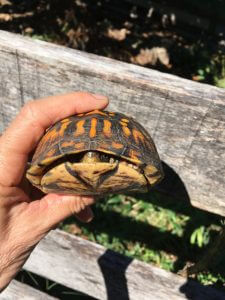
This Shell, that has provided the Box Turtle protection for millions of years, is no match for vehicles .
The unique defense mechanism of the Eastern Box Turtle has allowed for this small unambiguous reptile to survive on this planet for millions of years. It is the only animal that responds to danger by quickly and quietly closing up its shell, to form a tight box. Here in his home, this ancient reptile is well suited to wait until the danger has passed.
Our powered and developed landscape is no place for such a small dinosaur as he now finds himself closing his shell in the middle of busy streets, on mowed lawns, in crop fields, logging roads, shopping centers and golf courses. There is so little land in Central Virginia that is not logged, farmed or developed, that generations of genetic diversity have been silently wiped out. To make matters even more interesting, the Box turtles ability to survive extensive damage and to heal itself is close to miraculous.
Wildlife rehabilitators work with Veterinarians to provides medical care to injured, sick, or orphaned wildlife. Their goal is to treat the animal by providing suitable diet and nutrition, and safe and sanitary shelter, while it recovers, with the goal to return it to its native habitat:
Wild animals that sustain injuries or illnesses preventing them from living successfully in the wild usually are euthanized (have their suffering ended in a humane fashion). Occasionally, individual animals that have recovered from their injuries but are not able to survive in the wild are placed in educational facilities.” (from National Wildlife Rehabilators website)
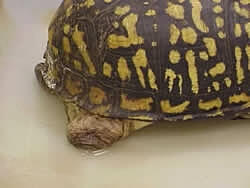
A three legged turtle often cannot contribute to future generations. Missing limbs make mating difficult and nest digging nearly impossible.
When Box turtles are found injured, and taken to a licensed wildlife veterinarian, and then supported by a rehabber, they are required to be returned to the exact place where they were found. Normally this is a good practice, as box turtles learn their habitat as they grow and will try to return to it if they are removed from it. Unfortunately often times this habitat is already compromised, which likely contributed to the injury.
Being a wildlife rehabber is a full time, unpaid, volunteer position, and most are not in a situation to be able to keep any of the animals that they tend to. Having to euthanize any animal is difficult, and it is often a thin line that must be drawn. You will find rehabbers releasing turtles that have handicaps (3 legs) or broken and missing pieces of their, shells making them vulnerable to predators. According to Virginia State Laws the only other option is euthanasia.
As the Box Turtle is not a game species in Virginia, it is silently disappearing through-out the state. Small and insignificant, there are few studies done within the commonwealth. Land held by the state is often used for other purposes, including logging, which leaves only private property as a last retreat for these ancient reptiles.
How Many Become Road Kill?
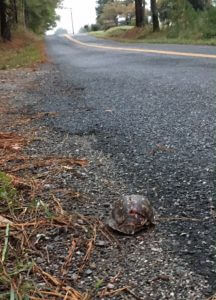
When finding a damaged turtle, it is important to put it in a dark, quiet place until help can be arranged.
Although it would be difficult to count the total number of turtles that become road kill every year in the United States, James Gibbs, a conservation biologist at the State University of New York in Syracuse decided to make an educated estimate. He took into consideration three factors: traffic density, the speed with which turtles cross the road and the number of roads in the US.
Gibbs estimate shows that turtle populations in the Northeast, Southeast and the Great lakes region suffer from a 10 to 20 percent mortality rate due to traffic encounters, high enough to deplete turtle populations. The Animal Protection Institute in Sacramento, California, places road kill mortality between one half and one million animals daily.
In Central Virginia alone 99% of injured turtles that make it to a wildlife veterinarian are suffering from a collision with a motorized vehicle. The remaining 1% is damage done by domestic canines.
Sanctuary or Death?
Turtles and encounters with motorized vehicles, is not a turtle problem, but a human consequence.
Here at the Box Turtle Sanctuary, our current focus is on education. We are not a rehabb facility, as the time commitment, both to become licensed and of the maintenance of in house rehabbs would not allow me to pursue the goal of the sanctuary which is to provide permanent safe shelter through natural, native habitat for misplaced eastern box turtles, due to habitat loss or that have been pets and are unable to be released into the wild. This includes animals that were damaged due to human encroachment, treated at wildlife vets, rehabbed and unable to be returned to the wild due to handicaps.
This being said, I am more then happy to educate turtle owners on how to achieve better environments and habitats for their pet turtles and I will continue to advocate for any turtle in need to make sure it gets the help that is necessary for its health.
Humans are responsible for this extreme loss of habitat, and as stewards of this earth and this land, it is our responsibility to provide habitat for all creatures that were residents before us.
So where do we go from here?
I am amazed at how Central Virginia continues to promote urban sprawl. Our residents and their children are becoming more and more removed from our natural world. We are at a critical time in our evolution, where humans are poised to create the next great extinction event.
Education is only the tip of the spear. Providing a safe sanctuary for these misplaced turtles, also provides an educational opportunity for study, exploration and a connection to the earth that we once shared .
Turtles are ancient, they are survivors, and they are part of our Earth.
PLEASE leave your comments
Wildlife Rehabbing
Wildlife Rehabilitation in Virginia
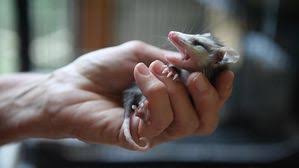 A rehabber, is someone who takes care of those that are recovering from a specific condition, to fix it up and make it better. Often times when someone mentions rehab, we think of drug or alcohol abuse and the process it takes to “get off the wagon”.
A rehabber, is someone who takes care of those that are recovering from a specific condition, to fix it up and make it better. Often times when someone mentions rehab, we think of drug or alcohol abuse and the process it takes to “get off the wagon”.
But a Rehabber , in wildlife terminology is the greatest asset we currently have to benefit our wildlife, and to help get them back into the wild where they belong. But it is not an easy road, nor is rehabbing wildlife the road to riches.
When Wildlife is injured or sick, and are presented to a wildlife veterinarian, they will prepare a plan to get that animal well as quickly and efficiently as possible. Our two major Wildlife centers in Virginia, the Richmond Wildlife Center and the Wildlife Center of Virginia, are both working at capacity and are busy with wildlife needing help. Fortunately, once their patients are stable and on the road to recovery, they are able to go to a rehabber that can give them the support and the care that they need until they are releasable.
You can find a list of licenced rehabilitators for Virginia here
WHAT IS A WILDLIFE REHABILITATOR?
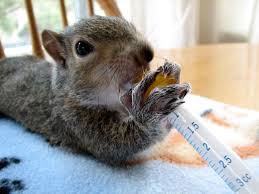
A wildlife rehabilitator, also known as a “rehabber,” is a professionally trained person, that works with Veterinarians to provides medical care to injured, sick, or orphaned wildlife. The goal of the rehabber is to medically treat the animal by providing suitable diet and nutrition, and to provide safe and sanitary shelter, so that it may return back to its natural habitat and family. The goal is not to make pets out of wildlife, to display them around humans, or to release any wildlife with handicaps in which they may not be able to protect themselves, not healthy enough to thrive, unable to fit in with other wildlife, or become vulnerable to predators. Wild animals that sustain injuries or illnesses preventing them from living successfully in the wild usually are euthanized (have their suffering ended in a humane fashion). Occasionally, individual animals that have recovered from their injuries but are not able to survive in the wild are placed in educational facilities.
Rehabbing Wildlife is an elaborate and time consuming undertaking, and there is no pay involved. Rehabbers work each and every day, all year long taking care of the animals in their care, but there is nothing more rewarding then watching that animal rejoin its family when it is returned to the wild.
HOW TO BECOME A WILDLIFE REHABILITATOR:
To become a wildlife rehabber, you will need to locate a licensed rehabber near you that has knowledge and experience rehabbing the species of animal that you are interested in working with.
To become a rehabber, you will first need to decide what species you would like to work with. In Virginia, there is no path that will allow you to focus on a specific animal, you will find you will need to learn how to rehab other animals as well.
Locate a rehabber in your area who has extensive experience rehabbing those animals. To find a list of rehabbers in your area, call your local Animal Shelter, Humane Society, or visit this web site: www.nwrawildlife.org
Put in lots of volunteer time with a permitted rehabber before you make your final decision. Find out all you can about the nature of the animal, medical treatments, time, commitment, and finances (rehabbers pay for the cost of everything).
Rehabbers need to obtain specific knowledge including:
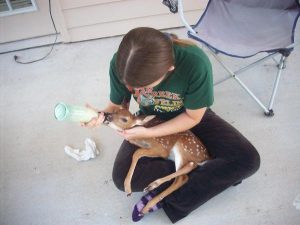
- behavior,
- diseases,
- diagnosis,
- wounds and injuries,
- anatomy of the species,
- first aid training,
- triage treatment,
- drugs and drug administration
Once you are sure you want to be a wildlife rehabber, you are ready to apply for your state permit. In Virginia this will require a 2-year apprenticeship program before you may legally obtain a permit to rehab. During this 2-year period, a legally permitted rehabber will supervise you. To obtain the rehab application, call Dept. of Game & Inland Fisheries:(804) 367-1000.
Wildlife rehabbers are required to attend wildlife training annually to keep their Federal or State permit legal and updated, and these classes are available at the Wildlife Center of Virginia, for a nominal fee.
Birds are protected by federal law and a Special Purpose Federal permit is required to handle and rehab birds. Click to learn more about acquiring a Federal permit.
Wildlife Centers and Hospitals receive thousands of calls from communities all over the country every year from compassionate citizens who see injured wildlife and want to help. Most injuries to wildlife are created by man, and as we destroy more and more of our natural world, we can expect more injuries to wildlife as they struggle just to survive.
Wildlife rehabbers are needed now more then ever, So if you have a love of wildlife, they could use your help now more then ever. Please do your part to help Wildlife in your area!

